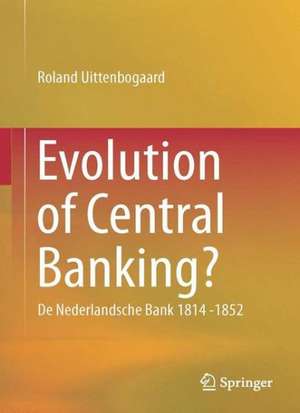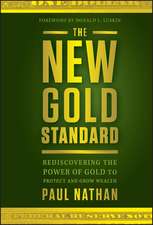Evolution of Central Banking?: De Nederlandsche Bank 1814 -1852
Autor Roland Uittenbogaarden Limba Engleză Hardback – 16 ian 2015
"On the occasion of the Nederlandsche Bank's 200th Anniversary, it is good to have a new, and an extremely good, history of its founding and first fifty years of operation. The only previous account of this period of the DNB's history was legalistic and did not sufficiently place the Bank´s development in its wider context. Uittenbogaard's book provides a much broader, and better, story of the personnel, economics, and finance of the DNB at this juncture." - Charles Goodhart, LSE.
| Toate formatele și edițiile | Preț | Express |
|---|---|---|
| Paperback (1) | 381.98 lei 43-57 zile | |
| Springer International Publishing – 6 oct 2016 | 381.98 lei 43-57 zile | |
| Hardback (1) | 389.11 lei 43-57 zile | |
| Springer International Publishing – 16 ian 2015 | 389.11 lei 43-57 zile |
Preț: 389.11 lei
Nou
Puncte Express: 584
Preț estimativ în valută:
74.46€ • 77.94$ • 61.97£
74.46€ • 77.94$ • 61.97£
Carte tipărită la comandă
Livrare economică 31 martie-14 aprilie
Preluare comenzi: 021 569.72.76
Specificații
ISBN-13: 9783319106168
ISBN-10: 3319106163
Pagini: 170
Ilustrații: XV, 170 p. 14 illus. in color.
Dimensiuni: 155 x 235 x 17 mm
Greutate: 0.44 kg
Ediția:2015
Editura: Springer International Publishing
Colecția Springer
Locul publicării:Cham, Switzerland
ISBN-10: 3319106163
Pagini: 170
Ilustrații: XV, 170 p. 14 illus. in color.
Dimensiuni: 155 x 235 x 17 mm
Greutate: 0.44 kg
Ediția:2015
Editura: Springer International Publishing
Colecția Springer
Locul publicării:Cham, Switzerland
Public țintă
ResearchCuprins
Introduction.- Theories on the Emergence and Development of Central Banking.- Dutch Economy and State 1800 - 1860.- Establishment of De Nederlandsche Bank in 1814.- Corporate Governance of DNB.- Relationship to the Government.- DNB's Role in the Payment System (1814 - 1852).- DNB's Credit Policy (1814 - 1870).- Summary and Conclusion.- Annexes: Granger Causality Test, Market Rate and Bank Rate.- Ordered-Probit Regressions.- A Monetary Policy Reaction Function for DNB 1814 - 1870.- Literature.
Textul de pe ultima copertă
The book analyses the establishment of De Nederlandsche Bank and its early development as a case study to test competing theories on the historical development of central banking. It is shown that the establishment of DNB can be explained by both the fiscal theory and the financial stability theory. Later development makes clear that the financial stability role of DNB prevailed. DNB´s bank notes were not forced onto the public and competition was fierce. A prudent and independent stance was necessary to be able to play its intended role. This meant that DNB played a modest role in the Amsterdam money market until 1852. By 1852 it had established itself to become the central bank. By then its bank notes had become generally accepted and it could start to operate as a reserve bank. Also the market context had changed dramatically, its competitors had been driven out of the market and several credit institutions had become customers of DNB.
"On the occasion of the Nederlandsche Bank's 200th Anniversary, it is good to have a new, and an extremely good, history of its founding and first fifty years of operation. The only previous account of this period of the DNB's history was legalistic and did not sufficiently place the Bank´s development in its wider context. Uittenbogaard's book provides a much broader, and better, story of the personnel, economics, and finance of the DNB at this juncture." - Charles Goodhart, LSE.
"On the occasion of the Nederlandsche Bank's 200th Anniversary, it is good to have a new, and an extremely good, history of its founding and first fifty years of operation. The only previous account of this period of the DNB's history was legalistic and did not sufficiently place the Bank´s development in its wider context. Uittenbogaard's book provides a much broader, and better, story of the personnel, economics, and finance of the DNB at this juncture." - Charles Goodhart, LSE.
Caracteristici
Presents a systematic case study of the early development of the Dutch central bank (DNB) Offers the first detailed analysis of the establishment of the Dutch central bank accessible to an international audience Provides full contextual treatment of the development of DNB, in relation to government, its governance and market conditions













